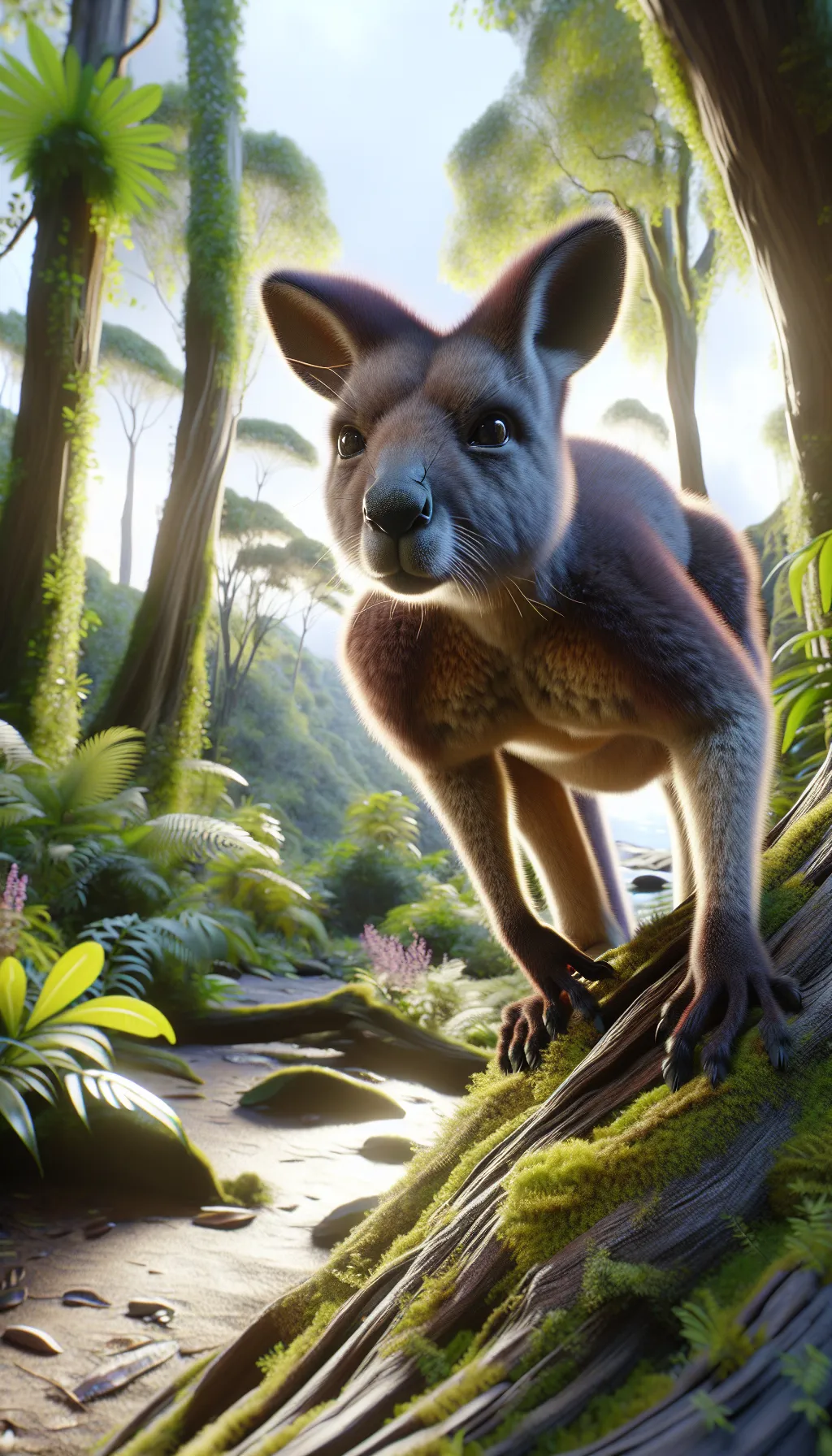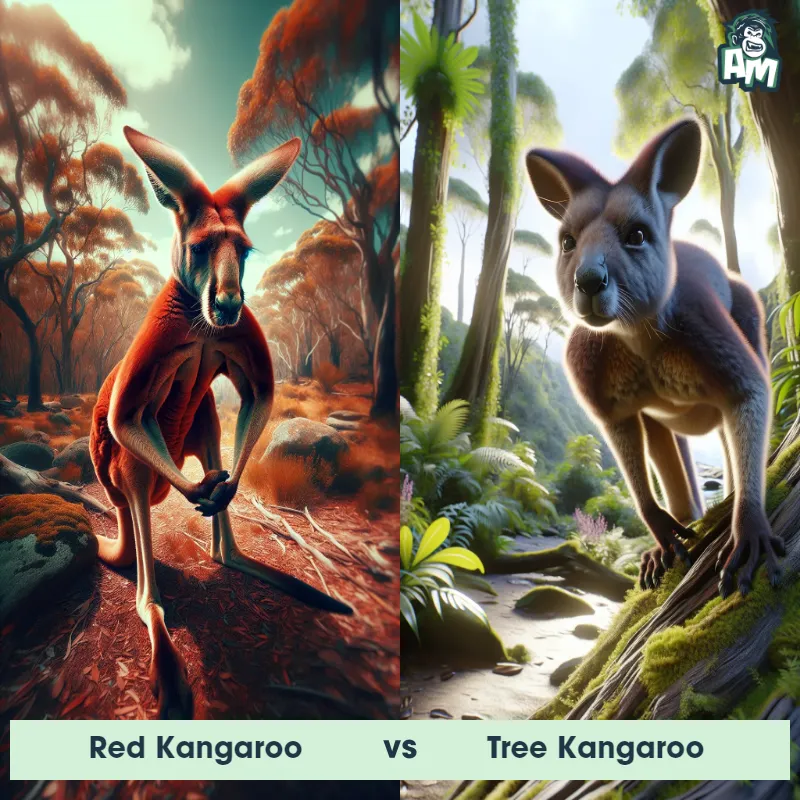The Tree Kangaroo
The Tree Kangaroo, also known as the Boongary, is a unique marsupial that is closely related to kangaroos and wallabies. Unlike its ground-dwelling relatives, the Tree Kangaroo has adapted to an arboreal lifestyle, spending most of its time in trees. It is primarily found in the rainforests of Papua New Guinea and northeastern Australia. The Tree Kangaroo has a robust body with strong forelimbs and hindlimbs for climbing. It has a large tail, which helps with balance, and powerful claws for gripping tree branches. Their fur varies in coloration, but is often dark-brown, providing excellent camouflage in the dense forest. The pouch of the female Tree Kangaroo is forward-facing to prevent debris from entering while climbing. These fascinating creatures have evolved to live in the treetops, making them skillful climbers with an impressive ability to leap between branches.

| Tree Kangaroo | |
|---|---|
| Size | 3-6 feet (0.9-1.8 meters) |
| Weight | 15-33 pounds (7-15 kilograms) |
| Speed | 15mph (24km/h) |
| Key Strength | Agility and jumping abilities |
| Biggest Weakness | Lack of aggression |
| Scientific Name | Dendrolagus |
| Family | Macropodidae |
| Habitat | Rainforests |
| Geography | Papua New Guinea and northeastern Australia |
| Diet | Herbivorous |
| Lifespan | 10 years - 20 years |

The Tree Kangaroo
The Tree Kangaroo, also known as the Boongary, is a unique marsupial that is closely related to kangaroos and wallabies. Unlike its ground-dwelling relatives, the Tree Kangaroo has adapted to an arboreal lifestyle, spending most of its time in trees. It is primarily found in the rainforests of Papua New Guinea and northeastern Australia. The Tree Kangaroo has a robust body with strong forelimbs and hindlimbs for climbing. It has a large tail, which helps with balance, and powerful claws for gripping tree branches. Their fur varies in coloration, but is often dark-brown, providing excellent camouflage in the dense forest. The pouch of the female Tree Kangaroo is forward-facing to prevent debris from entering while climbing. These fascinating creatures have evolved to live in the treetops, making them skillful climbers with an impressive ability to leap between branches.
Fun Fact: The Tree Kangaroo is considered an excellent jumper, capable of leaping distances of up to 9 meters 30 feet from one tree to another, making it one of the greatest leapers among mammals.
| Tree Kangaroo | |
|---|---|
| Size | 3-6 feet (0.9-1.8 meters) |
| Weight | 15-33 pounds (7-15 kilograms) |
| Speed | 15mph (24km/h) |
| Key Strength | Agility and jumping abilities |
| Biggest Weakness | Lack of aggression |
| Scientific Name | Dendrolagus |
| Family | Macropodidae |
| Habitat | Rainforests |
| Geography | Papua New Guinea and northeastern Australia |
| Diet | Herbivorous |
| Lifespan | 10 years - 20 years |
Tree Kangaroo Matchups
We use AI to simulate matchups between the Tree Kangaroo and other animals. Our simulation considers size, strength, and natural predatory behaviors to determine the most likely outcome.

Can't find the Matchup you want?
Create Your Own MatchupTree Kangaroo: Diet, Predators, Aggression, and Defensive Behaviors
What do Tree Kangaroos eat?
Tree Kangaroos primarily feed on leaves, fruits, flowers, and bark from a variety of trees and plants in their natural habitat. Their diet mainly consists of low-calorie, high-fiber foods, making them adapted to digesting tough vegetation found in the forests they inhabit.
Do Tree Kangaroos have any predators?
While adult Tree Kangaroos do not have many natural predators due to their arboreal lifestyle and elusive behavior, they are sometimes targeted by birds of prey, large snakes, and feral dogs in their native rainforest habitats. Tree Kangaroo joeys are more vulnerable to predation and are often targeted by arboreal predators such as pythons and tree-climbing mammals.
Are Tree Kangaroos aggressive?
Tree Kangaroos are known to be shy and solitary animals, usually avoiding confrontations with other animals, including humans. They are not inherently aggressive but may exhibit defensive behavior if they feel threatened or cornered.
Do Tree Kangaroos fight?
Tree Kangaroos typically do not engage in physical fights as a primary means of resolving conflicts. They are more inclined to avoid conflicts through evasion and tree-climbing abilities rather than resorting to aggressive behavior.
How do Tree Kangaroos defend themselves?
Tree Kangaroos have several defense mechanisms to protect themselves from potential threats in their environment. They rely on their excellent climbing and leaping skills to escape danger by fleeing up into the trees, where they are well-adapted to moving swiftly through the canopy to safety.
What is the biggest weakness of Tree Kangaroos in a fight?
One of the main weaknesses of Tree Kangaroos in a fight is their lack of physical defense mechanisms. While they are agile climbers and leapers, they do not have strong natural weapons, such as sharp claws or powerful jaws, to defend themselves effectively in direct confrontations with predators or threats. Their survival strategy is primarily based on avoiding conflict rather than engaging in physical combat.
Fun Fact: Despite their relatively large size, Tree Kangaroos are skilled and nimble climbers, capable of moving effortlessly through the treetops, thanks to their specialized ankles and feet, which have adapted to grip branches securely.
Fun Fact: Tree Kangaroos have a unique adaptation called the "nasal pouch." This pouch, located behind their noses, acts as a resonating chamber when they vocalize. This amplifies their calls, helping them communicate over long distances within the forest canopy.











